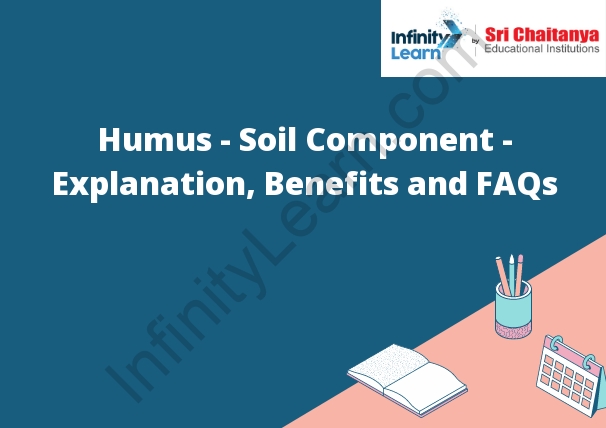Table of Contents
What is Humus? Component of Soil:
Humus is a component of soil that is made up of decomposed plant and animal matter. It is a dark, rich, and fertile soil amendment that is high in organic matter. Humus is a good source of nutrients for plants, and it helps to improve the soil’s structure, water retention, and ability to suppress pests and diseases.

Minerals:
Minerals are inorganic substances found in the earth’s crust. They are essential to human life and are used in products we use every day. Some minerals are common, such as quartz, while others are rare, such as diamonds.
Minerals are found in many different forms, including rocks, ores, and gems. They can be divided into two categories: metallic and nonmetallic. Metallic minerals are those that contain metals, such as gold and copper. Nonmetallic minerals do not contain metals, such as quartz and mica.
Minerals are used in many different products. Some common products that contain minerals are construction materials, such as concrete and asphalt; metal products, such as cars and appliances; and consumer products, such as toothpaste and shampoo.
Minerals are essential to human life. We need them to grow and function properly. They are also used in products that improve our health and well-being. We need to be sure to have a good supply of minerals so that we can continue to enjoy these benefits.
Water:
Water is a transparent, tasteless, odorless, and nearly colorless chemical substance that is the main constituent of Earth’s streams, lakes, and oceans, and the fluids of most living organisms. It is formed by the combination of hydrogen and oxygen atoms, and is essential for all known forms of life.
Water is a transparent, tasteless, odorless, and nearly colorless chemical substance that is the main constituent of Earth’s streams, lakes, and oceans, and the fluids of most living organisms. It is formed by the combination of hydrogen and oxygen atoms, and is essential for all known forms of life. Oxygen: Oxygen is a colorless, odorless, and tasteless gas that is necessary for all known forms of life. It is the third most abundant element in the universe, and makes up about 21% of the Earth’s atmosphere.
Organic Matter:
Organic matter is matter composed of organic compounds. It is found in all living things and in many dead things. Organic matter includes all the tissues of plants and animals, the cellulose and lignin in their cell walls, and the natural fats and waxes that protect their cells.
Gases:
Gases are made up of molecules that are very far apart from each other. This means that they have a lot of empty space between them. Because of this, gases can be compressed into a small space.
Gases also flow easily from one place to another. This means that they can spread out quickly and fill up any space that is available.
Microorganisms:
There are many different types of microorganisms, including bacteria, viruses, and fungi. Each type of microorganism has its own unique set of characteristics and abilities.
Bacteria are single-celled organisms that can exist in a variety of different environments. They are typically very small, and can range in size from 0.2 micrometers to several millimeters in length. Bacteria are able to survive in a wide range of conditions, and can be found in both hot and cold environments, as well as in both wet and dry environments.
Bacteria are able to reproduce by dividing in two, and can form colonies of millions of cells. They can also form spores, which are resistant to environmental stressors and can survive for long periods of time.
Bacteria are responsible for a variety of different diseases, including strep throat, pneumonia, and tuberculosis. They can also cause food poisoning and skin infections.
Viruses are also single-celled organisms, but they are much smaller than bacteria. They are typically between 0.02 and 0.2 micrometers in size. Viruses are able to survive only in a host cell, where they hijack the cell’s replication machinery to reproduce.
Viruses are responsible for a variety of diseases, including the common cold, the flu, and AIDS. They can also cause tumors and cancers.
Fungi are a type of microorganism that includes both
Humification:
Humification is the process of organic matter being converted into humus. This process is accelerated by the presence of microorganisms, such as bacteria and fungi, that break down the organic matter into smaller molecules. The humus then becomes part of the soil and helps to improve the soil’s fertility and ability to hold water and nutrients.
Benefits of Soil Organic and Humus Matter
Soil organic matter (SOM) is the living and dead plant and animal material in soils. SOM contains about 50% carbon. The carbon in SOM is important because it is a major component of soil fertility and helps to improve soil structure, water holding capacity, and nutrient holding capacity.
The benefits of SOM are:
Soil organic matter is important for the fertility of soils. It helps to improve the soil structure, water holding capacity, and nutrient holding capacity.
Organic matter can improve the ability of soils to support plant growth.
Organic matter can help to suppress plant diseases and pests.
Organic matter can help to reduce soil erosion.
Organic matter can help to improve the soil’s ability to cycle nutrients.
Organic matter can help to reduce greenhouse gas emissions from soils.









